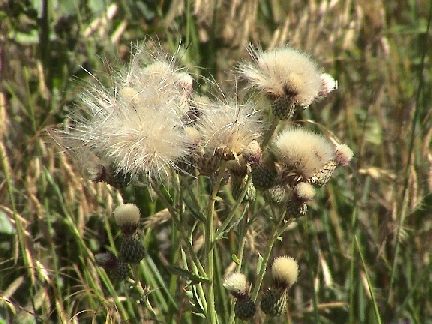Canada Thistle (Cirsium arvense)
 Identification
Identification
Originally from Eurasia, Canada thistle is an aggressive, colony-forming, creeping perennial weed that develops from seed or vegetative buds in its root system. Horizontal roots(rhizomes) my extend 15 feet and vertical roots may grow 6 to 15 feet deep.
It emerges from its root system in mid- to late-spring and forms rosettes. Plants grow from 1 to 4 feet in height. Flowers are unisexual, small and are lavender to purple(sometimes white) in color. Leaves are green, alternate, crinkly, and have well developed sharp spines along their edges. Canada thistle begins to flower in late spring to early summer and may produce, on average, 1,000 to 1,500 seeds per plant.
The small, dry, single-seeded fruits(achenes) have a white feathery structure attached to the seed base. Seeds may be transported long distances by wind, water, by being attached to animals, clothing, farm equipment and other vehicles, or with contaminated crop seed. Canada thistle is common throughout Adams County.
Control
 Canada thistle is difficult to control due to its extensive root system and stored nutrients which allow the plant recover from any one control method. The key to controlling Canada thistle is to combine control methods in order to stress the plant and force it to use nutrients stored in its root system. A sound management plan must be developed to implement over several years to realize success.
Canada thistle is difficult to control due to its extensive root system and stored nutrients which allow the plant recover from any one control method. The key to controlling Canada thistle is to combine control methods in order to stress the plant and force it to use nutrients stored in its root system. A sound management plan must be developed to implement over several years to realize success.
Chemical
Herbicides should be applied in late-springs/early summer and again in the fall. Herbicides that are recommended for use on Canada thistle, either independently or in combination, are: picloram(Tordon 22K), clopyralid(Stinger, Transline), clopyralid plus 2,4-D(Curtail), chlorsulfuron(Telar), chlorsulfuron methyl(Escort), glyphosate(Roundup, Rodeo), and dicamba(Banvel). Always read and follow label instructions when making any application. Consult your local pesticide dealer, County Weed Supervisor, or Extension Agent for specific recommendations.
Mechanical
Mowing is recommended for Canada thistle during the summer prior to seed set and repeated 2 to 3 times. Since Canada thistle is a deep-rooted perennial, hand-pulling is not very effective.



